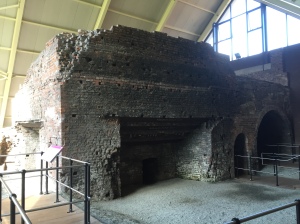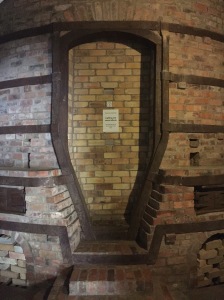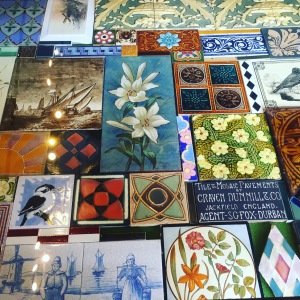#35: UNESCO World Heritage Sites – Ironbridge Gorge
Ironbridge Gorge: cradle of the Industrial Revolution. An industrial World Heritage site, recognised because the developments at Ironbridge exemplify the rapid industrial progress of the 18th century, and because the techniques created and used there changed industry and society forever – not only in Britain but worldwide. Its unique position in world history is the reason why it was inscribed onto the UNESCO World Heritage list.
The area (originally known as Coalbrookdale) gets its modern name literally from the iron bridge which spans the Gorge, part of the Severn Valley. The Iron Bridge is the first known example of a bridge constructed from iron in the world, and therefore the first ever use of iron as an architectural material. The principles of its construction influenced engineering and technology across the world. The whole industrial landscape of the Gorge is included in the World Heritage site which comprises mines, foundries, factories, furnaces, warehouses, public buildings, infrastructure and transport systems, in addition to both workers’ and masters’ housing. There are ten museums included in the site.
In some ways, I thought that exploring Ironbridge would be similar to visiting Saltaire and the Derwent Valley mills. It was somewhat different though, as those sites mainly focus on industrial architecture, whereas with Ironbridge it’s the industry itself and the processes used that are the key, although the remaining architecture is also an interesting attraction.
My first stop in Ironbridge was the Museum of the Gorge. I wanted to learn a little about the history of the area and the man who made the iron bridge, before taking a look at the bridge itself. Seeing Ironbridge now, it’s hard to imagine it as a dirty, smoky, industrial area. However, as is often the case with these sites it was geography that determined Ironbridge’s commercial success. The reason there was so much industry in the Gorge was because the raw materials were there: coal, wood, iron ore and water. It was easier and cheaper to build the factories and foundries close to the source of the raw materials required for production rather than have to transport those materials great distances to be processed. The River Severn, which flows through the Gorge, also provided an easily accessible means of transporting the finished goods around the world.
The great industrial discovery made at Ironbridge was the means of producing cast iron which was both strong and cheap to manufacture. Prior to this discovery, cast iron could only be made in furnaces fired by charcoal which was in short supply as forests were being used up rapidly, so this made cast iron expensive. Wrought iron was similarly expensive because it had to be individually hand worked. Attempts were made to use coal (which was much more plentiful at the time) as the fuel for smelting iron, but this resulted in impurities such as sulphur being absorbed into the iron making it brittle and unreliable. In 1709 however, Abraham Darby (who founded the iron works at Coalbrookdale) found a means of smelting iron using coke; half burnt coal which has had the impurities burnt out of it.
The iron Darby produced using coke had similar properties to wrought iron but was much cheaper to produce as it could be cast into moulds and mass produced. This technique would eventually be used to make machinery, furniture, stoves, utensils and even decorative items such as fountains and statues.
The iron bridge however, erected in 1779, was another undertaking altogether. A bridge over the Severn was required because the industrial advances which had already taken place in the Gorge gave rise to the need for skilled workers who lived on the far side of the river to cross the water to come to work. Frequent floods meant ferries were unreliable and dangerous, and often washed out the bridges. It was Abraham Darby III who solved the problem by building an iron bridge. Not only did this ensure a stable structure which could withstand flooding, but it also showcased what could be done with cast iron and eventually became a wonder of the age, attracting a steady stream of ‘tourists’ keen to see the industrial advances being made.
The bridge itself is beautiful. I expected a heavy, unattractive structure but instead the ironwork looks so light and airy yet is clearly so strong. I was fascinated to learn that as the bridge was the world’s first major construction made in iron, things like bolts and welding were unheard of so the bridge was put together using carpentry principles such as mortise and tenon joints as these were the only techniques known to the designer. Over time, the bridge became the catalyst for the architectural use of iron across the globe.
Opened on New Years Day 1881, the Iron Bridge was originally a toll bridge and stayed that way until the late 1950s. The bridge didn’t make much of an impact nationally until severe flooding in 1795 damaged most of the bridges on the Severn but the Iron Bridge stayed strong. After this, architects and engineers became much more interested in using iron for construction.
Whilst I was in the area I was also able to explore the other museums which make up the World Heritage site. The Coalport China Museum was undergoing refurbishment, so it was a little untidy, but it was nevertheless interesting to see the display kiln showing how the delicate china was stacked into ‘saggers’ (heavy clay pots) to protect it during firing. There was also an opportunity to learn about the process of producing the fine china for which Coalport is famous, including the fact that the patterns were hand painted onto the objects both before and after initial firing and that gilding has to be burnished by hand after firing to bring the shine up. It was easy to see how the process was labour intensive and why the fine china produced by Coalport was so expensive.
My favourite museum of the weekend was the Jackfield Tile Museum, where I learnt all about the process of making decorative tiles and saw examples of tiles ‘in situ’ as they would have been used by the Victorians, in pubs, underground stations, churches and public buildings such as railway stations. Jackfield was particularly well known for the production of encaustic tiles – the type typically seen in church floors where a tile has a pattern in a contrasting colour set into it. This is formed by impressing a shallow pattern into the tile blank before firing, firing the base, then adding coloured ‘slip clay’ (liquid clay) to create the contrast pattern before re firing. Other types of tiles were created using moulds to form a certain pattern, or hand decorated with glaze or paint.
Much like Coalport china, glazed and encaustic tiles may have had to be fired multiple times with various colours and details added each time to achieve the finished effect. It was fascinating to see the level of craftsmanship which went into producing these beautiful tiles, and the fact that the techniques and craftsmanship continue today. They even have a store of old moulds so they can recreate designs which are a couple of hundred years old to assist with restoration works at historical properties.
A busy weekend was finished off with a quick trip to the Tar Tunnel – a naturally occurring bitumen spring which produced barrels of tar for a number of years before the flow started to dry up, visiting the restored Darby House (home to the Darby family who were so key in the development of industry in the area), checking out the Bedlam furnaces – close to the banks of the Severn and one of the locations where parts of the Iron Bridge may have been cast, having a wander round the Victorian town at Blists Hill which shows off aspects of life during the industrial revolution and finally, checking out the Hay Inclined Plane – an innovative method of moving canal barges from the Shropshire Canal at the top of the gorge to the river level at the bottom of the Gorge. The latter particularly contributed to Ironbridge’s success.
In what is now a picturesque rural valley it’s difficult to imagine the smoke and flames of the enormous furnaces, the dirt and dust of the mines, the noise of the machinery and industries and the fact that this place once led the world in technology and innovation. A fascinating weekend, with much to see and do. For more information on the Gorge and its museums see: http://www.ironbridge.org.uk/














